+ Open data
Open data
- Basic information
Basic information
| Entry | Database: PDB / ID: 8cvs | ||||||
|---|---|---|---|---|---|---|---|
| Title | Human PA200-20S proteasome with MG-132 | ||||||
 Components Components |
| ||||||
 Keywords Keywords | HYDROLASE/INHIBITOR /  proteolysis / proteolysis /  protein degradation / protein degradation /  complex / complex /  inhibitor / MG-132 / inhibitor / MG-132 /  MG132 / HYDROLASE-INHIBITOR complex MG132 / HYDROLASE-INHIBITOR complex | ||||||
| Function / homology |  Function and homology information Function and homology informationspermatoproteasome complex / sperm DNA condensation / peptidase activator activity / purine ribonucleoside triphosphate binding /  regulation of endopeptidase activity / Regulation of ornithine decarboxylase (ODC) / proteasome core complex / Cross-presentation of soluble exogenous antigens (endosomes) / regulation of endopeptidase activity / Regulation of ornithine decarboxylase (ODC) / proteasome core complex / Cross-presentation of soluble exogenous antigens (endosomes) /  Somitogenesis / proteasomal ubiquitin-independent protein catabolic process ...spermatoproteasome complex / sperm DNA condensation / peptidase activator activity / purine ribonucleoside triphosphate binding / Somitogenesis / proteasomal ubiquitin-independent protein catabolic process ...spermatoproteasome complex / sperm DNA condensation / peptidase activator activity / purine ribonucleoside triphosphate binding /  regulation of endopeptidase activity / Regulation of ornithine decarboxylase (ODC) / proteasome core complex / Cross-presentation of soluble exogenous antigens (endosomes) / regulation of endopeptidase activity / Regulation of ornithine decarboxylase (ODC) / proteasome core complex / Cross-presentation of soluble exogenous antigens (endosomes) /  Somitogenesis / proteasomal ubiquitin-independent protein catabolic process / Somitogenesis / proteasomal ubiquitin-independent protein catabolic process /  immune system process / immune system process /  myofibril / myofibril /  proteasome binding / proteasome binding /  NF-kappaB binding / NF-kappaB binding /  proteasome endopeptidase complex / proteasome core complex, beta-subunit complex / proteasome core complex, alpha-subunit complex / threonine-type endopeptidase activity / negative regulation of inflammatory response to antigenic stimulus / response to organonitrogen compound / proteasome endopeptidase complex / proteasome core complex, beta-subunit complex / proteasome core complex, alpha-subunit complex / threonine-type endopeptidase activity / negative regulation of inflammatory response to antigenic stimulus / response to organonitrogen compound /  proteasome complex / proteolysis involved in protein catabolic process / proteasome complex / proteolysis involved in protein catabolic process /  sarcomere / Regulation of activated PAK-2p34 by proteasome mediated degradation / ciliary basal body / Autodegradation of Cdh1 by Cdh1:APC/C / APC/C:Cdc20 mediated degradation of Securin / Asymmetric localization of PCP proteins / SCF-beta-TrCP mediated degradation of Emi1 / NIK-->noncanonical NF-kB signaling / Ubiquitin-dependent degradation of Cyclin D / AUF1 (hnRNP D0) binds and destabilizes mRNA / TNFR2 non-canonical NF-kB pathway / Assembly of the pre-replicative complex / Vpu mediated degradation of CD4 / proteasomal protein catabolic process / Degradation of DVL / sarcomere / Regulation of activated PAK-2p34 by proteasome mediated degradation / ciliary basal body / Autodegradation of Cdh1 by Cdh1:APC/C / APC/C:Cdc20 mediated degradation of Securin / Asymmetric localization of PCP proteins / SCF-beta-TrCP mediated degradation of Emi1 / NIK-->noncanonical NF-kB signaling / Ubiquitin-dependent degradation of Cyclin D / AUF1 (hnRNP D0) binds and destabilizes mRNA / TNFR2 non-canonical NF-kB pathway / Assembly of the pre-replicative complex / Vpu mediated degradation of CD4 / proteasomal protein catabolic process / Degradation of DVL /  P-body / Ubiquitin Mediated Degradation of Phosphorylated Cdc25A / Dectin-1 mediated noncanonical NF-kB signaling / Hh mutants are degraded by ERAD / Cdc20:Phospho-APC/C mediated degradation of Cyclin A / Degradation of AXIN / Defective CFTR causes cystic fibrosis / Degradation of GLI1 by the proteasome / P-body / Ubiquitin Mediated Degradation of Phosphorylated Cdc25A / Dectin-1 mediated noncanonical NF-kB signaling / Hh mutants are degraded by ERAD / Cdc20:Phospho-APC/C mediated degradation of Cyclin A / Degradation of AXIN / Defective CFTR causes cystic fibrosis / Degradation of GLI1 by the proteasome /  lipopolysaccharide binding / Hedgehog ligand biogenesis / Activation of NF-kappaB in B cells / Negative regulation of NOTCH4 signaling / GSK3B and BTRC:CUL1-mediated-degradation of NFE2L2 / G2/M Checkpoints / Vif-mediated degradation of APOBEC3G / Autodegradation of the E3 ubiquitin ligase COP1 / Hedgehog 'on' state / Regulation of RUNX3 expression and activity / Degradation of GLI2 by the proteasome / GLI3 is processed to GLI3R by the proteasome / MAPK6/MAPK4 signaling / FBXL7 down-regulates AURKA during mitotic entry and in early mitosis / lysine-acetylated histone binding / response to virus / APC/C:Cdh1 mediated degradation of Cdc20 and other APC/C:Cdh1 targeted proteins in late mitosis/early G1 / ABC-family proteins mediated transport / Degradation of beta-catenin by the destruction complex / Oxygen-dependent proline hydroxylation of Hypoxia-inducible Factor Alpha / response to organic cyclic compound / CDK-mediated phosphorylation and removal of Cdc6 / CLEC7A (Dectin-1) signaling / SCF(Skp2)-mediated degradation of p27/p21 / Regulation of expression of SLITs and ROBOs / lipopolysaccharide binding / Hedgehog ligand biogenesis / Activation of NF-kappaB in B cells / Negative regulation of NOTCH4 signaling / GSK3B and BTRC:CUL1-mediated-degradation of NFE2L2 / G2/M Checkpoints / Vif-mediated degradation of APOBEC3G / Autodegradation of the E3 ubiquitin ligase COP1 / Hedgehog 'on' state / Regulation of RUNX3 expression and activity / Degradation of GLI2 by the proteasome / GLI3 is processed to GLI3R by the proteasome / MAPK6/MAPK4 signaling / FBXL7 down-regulates AURKA during mitotic entry and in early mitosis / lysine-acetylated histone binding / response to virus / APC/C:Cdh1 mediated degradation of Cdc20 and other APC/C:Cdh1 targeted proteins in late mitosis/early G1 / ABC-family proteins mediated transport / Degradation of beta-catenin by the destruction complex / Oxygen-dependent proline hydroxylation of Hypoxia-inducible Factor Alpha / response to organic cyclic compound / CDK-mediated phosphorylation and removal of Cdc6 / CLEC7A (Dectin-1) signaling / SCF(Skp2)-mediated degradation of p27/p21 / Regulation of expression of SLITs and ROBOs /  nuclear matrix / FCERI mediated NF-kB activation / Regulation of PTEN stability and activity / Interleukin-1 signaling / Orc1 removal from chromatin / Regulation of RAS by GAPs / Separation of Sister Chromatids / Regulation of RUNX2 expression and activity / The role of GTSE1 in G2/M progression after G2 checkpoint / UCH proteinases / KEAP1-NFE2L2 pathway / Antigen processing: Ubiquitination & Proteasome degradation / Downstream TCR signaling / nuclear matrix / FCERI mediated NF-kB activation / Regulation of PTEN stability and activity / Interleukin-1 signaling / Orc1 removal from chromatin / Regulation of RAS by GAPs / Separation of Sister Chromatids / Regulation of RUNX2 expression and activity / The role of GTSE1 in G2/M progression after G2 checkpoint / UCH proteinases / KEAP1-NFE2L2 pathway / Antigen processing: Ubiquitination & Proteasome degradation / Downstream TCR signaling /  Neddylation / RUNX1 regulates transcription of genes involved in differentiation of HSCs / positive regulation of NF-kappaB transcription factor activity / Neddylation / RUNX1 regulates transcription of genes involved in differentiation of HSCs / positive regulation of NF-kappaB transcription factor activity /  peptidase activity / ER-Phagosome pathway / peptidase activity / ER-Phagosome pathway /  regulation of inflammatory response / postsynapse / proteasome-mediated ubiquitin-dependent protein catabolic process / secretory granule lumen / regulation of inflammatory response / postsynapse / proteasome-mediated ubiquitin-dependent protein catabolic process / secretory granule lumen /  endopeptidase activity / response to oxidative stress / ficolin-1-rich granule lumen / endopeptidase activity / response to oxidative stress / ficolin-1-rich granule lumen /  nuclear body / nuclear body /  ribosome / Ub-specific processing proteases / nuclear speck / ribosome / Ub-specific processing proteases / nuclear speck /  cadherin binding cadherin bindingSimilarity search - Function | ||||||
| Biological species |   Homo sapiens (human) Homo sapiens (human) | ||||||
| Method |  ELECTRON MICROSCOPY / ELECTRON MICROSCOPY /  single particle reconstruction / single particle reconstruction /  cryo EM / Resolution: 3.1 Å cryo EM / Resolution: 3.1 Å | ||||||
 Authors Authors | Zhao, J. | ||||||
| Funding support | 1items
| ||||||
 Citation Citation |  Journal: Proc Natl Acad Sci U S A / Year: 2022 Journal: Proc Natl Acad Sci U S A / Year: 2022Title: Structural insights into the human PA28-20S proteasome enabled by efficient tagging and purification of endogenous proteins. Authors: Jianhua Zhao / Suraj Makhija / Chenyu Zhou / Hanxiao Zhang / YongQiang Wang / Monita Muralidharan / Bo Huang / Yifan Cheng /  Abstract: The ability to produce folded and functional proteins is a necessity for structural biology and many other biological sciences. This task is particularly challenging for numerous biomedically ...The ability to produce folded and functional proteins is a necessity for structural biology and many other biological sciences. This task is particularly challenging for numerous biomedically important targets in human cells, including membrane proteins and large macromolecular assemblies, hampering mechanistic studies and drug development efforts. Here we describe a method combining CRISPR-Cas gene editing and fluorescence-activated cell sorting to rapidly tag and purify endogenous proteins in HEK cells for structural characterization. We applied this approach to study the human proteasome from HEK cells and rapidly determined cryogenic electron microscopy structures of major proteasomal complexes, including a high-resolution structure of intact human PA28αβ-20S. Our structures reveal that PA28 with a subunit stoichiometry of 3α/4β engages tightly with the 20S proteasome. Addition of a hydrophilic peptide shows that polypeptides entering through PA28 are held in the antechamber of 20S prior to degradation in the proteolytic chamber. This study provides critical insights into an important proteasome complex and demonstrates key methodologies for the tagging of proteins from endogenous sources. | ||||||
| History |
|
- Structure visualization
Structure visualization
| Structure viewer | Molecule:  Molmil Molmil Jmol/JSmol Jmol/JSmol |
|---|
- Downloads & links
Downloads & links
- Download
Download
| PDBx/mmCIF format |  8cvs.cif.gz 8cvs.cif.gz | 1.7 MB | Display |  PDBx/mmCIF format PDBx/mmCIF format |
|---|---|---|---|---|
| PDB format |  pdb8cvs.ent.gz pdb8cvs.ent.gz | 1.3 MB | Display |  PDB format PDB format |
| PDBx/mmJSON format |  8cvs.json.gz 8cvs.json.gz | Tree view |  PDBx/mmJSON format PDBx/mmJSON format | |
| Others |  Other downloads Other downloads |
-Validation report
| Arichive directory |  https://data.pdbj.org/pub/pdb/validation_reports/cv/8cvs https://data.pdbj.org/pub/pdb/validation_reports/cv/8cvs ftp://data.pdbj.org/pub/pdb/validation_reports/cv/8cvs ftp://data.pdbj.org/pub/pdb/validation_reports/cv/8cvs | HTTPS FTP |
|---|
-Related structure data
| Related structure data |  27015MC 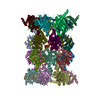 7nanC 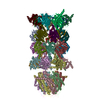 7naoC 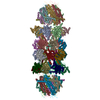 7napC 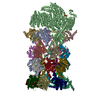 7naqC 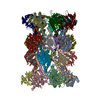 8cvrC 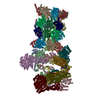 8cvtC 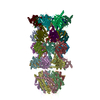 8cxbC M: map data used to model this data C: citing same article ( |
|---|---|
| Similar structure data | Similarity search - Function & homology  F&H Search F&H Search |
- Links
Links
- Assembly
Assembly
| Deposited unit | 
|
|---|---|
| 1 |
|
- Components
Components
-Proteasome subunit alpha type- ... , 7 types, 14 molecules AOBPCQDRESFTGU
| #1: Protein |  / Macropain subunit C3 / Multicatalytic endopeptidase complex subunit C3 / Proteasome component C3 / Macropain subunit C3 / Multicatalytic endopeptidase complex subunit C3 / Proteasome component C3Mass: 25927.535 Da / Num. of mol.: 2 / Source method: isolated from a natural source / Source: (natural)   Homo sapiens (human) Homo sapiens (human)References: UniProt: P25787,  proteasome endopeptidase complex proteasome endopeptidase complex#2: Protein |  / Macropain subunit C9 / Multicatalytic endopeptidase complex subunit C9 / Proteasome component C9 / ...Macropain subunit C9 / Multicatalytic endopeptidase complex subunit C9 / Proteasome component C9 / Proteasome subunit L / Macropain subunit C9 / Multicatalytic endopeptidase complex subunit C9 / Proteasome component C9 / ...Macropain subunit C9 / Multicatalytic endopeptidase complex subunit C9 / Proteasome component C9 / Proteasome subunit LMass: 29525.842 Da / Num. of mol.: 2 / Source method: isolated from a natural source / Source: (natural)   Homo sapiens (human) Homo sapiens (human)References: UniProt: P25789,  proteasome endopeptidase complex proteasome endopeptidase complex#3: Protein |  / Proteasome subunit RC6-1 / Proteasome subunit XAPC7 / Proteasome subunit RC6-1 / Proteasome subunit XAPC7Mass: 27929.891 Da / Num. of mol.: 2 / Source method: isolated from a natural source / Source: (natural)   Homo sapiens (human) Homo sapiens (human)References: UniProt: O14818,  proteasome endopeptidase complex proteasome endopeptidase complex#4: Protein |  / Macropain zeta chain / Multicatalytic endopeptidase complex zeta chain / Proteasome zeta chain / Macropain zeta chain / Multicatalytic endopeptidase complex zeta chain / Proteasome zeta chainMass: 26435.977 Da / Num. of mol.: 2 / Source method: isolated from a natural source / Source: (natural)   Homo sapiens (human) Homo sapiens (human)References: UniProt: P28066,  proteasome endopeptidase complex proteasome endopeptidase complex#5: Protein |  / 30 kDa prosomal protein / PROS-30 / Macropain subunit C2 / Multicatalytic endopeptidase complex ...30 kDa prosomal protein / PROS-30 / Macropain subunit C2 / Multicatalytic endopeptidase complex subunit C2 / Proteasome component C2 / Proteasome nu chain / 30 kDa prosomal protein / PROS-30 / Macropain subunit C2 / Multicatalytic endopeptidase complex ...30 kDa prosomal protein / PROS-30 / Macropain subunit C2 / Multicatalytic endopeptidase complex subunit C2 / Proteasome component C2 / Proteasome nu chainMass: 29595.627 Da / Num. of mol.: 2 / Source method: isolated from a natural source / Source: (natural)   Homo sapiens (human) Homo sapiens (human)References: UniProt: P25786,  proteasome endopeptidase complex proteasome endopeptidase complex#6: Protein |  / Macropain subunit C8 / Multicatalytic endopeptidase complex subunit C8 / Proteasome component C8 / Macropain subunit C8 / Multicatalytic endopeptidase complex subunit C8 / Proteasome component C8Mass: 28469.252 Da / Num. of mol.: 2 / Source method: isolated from a natural source / Source: (natural)   Homo sapiens (human) Homo sapiens (human)References: UniProt: P25788,  proteasome endopeptidase complex proteasome endopeptidase complex#7: Protein |  / 27 kDa prosomal protein / p27K / Macropain iota chain / Multicatalytic endopeptidase complex iota ...27 kDa prosomal protein / p27K / Macropain iota chain / Multicatalytic endopeptidase complex iota chain / Proteasome iota chain / 27 kDa prosomal protein / p27K / Macropain iota chain / Multicatalytic endopeptidase complex iota ...27 kDa prosomal protein / p27K / Macropain iota chain / Multicatalytic endopeptidase complex iota chain / Proteasome iota chainMass: 27432.459 Da / Num. of mol.: 2 / Source method: isolated from a natural source / Source: (natural)   Homo sapiens (human) Homo sapiens (human)References: UniProt: P60900,  proteasome endopeptidase complex proteasome endopeptidase complex |
|---|
-Proteasome subunit beta type- ... , 7 types, 14 molecules HVIWJXKYLZMaNb
| #8: Protein |  / Macropain chain Z / Multicatalytic endopeptidase complex chain Z / Proteasome subunit Z / Macropain chain Z / Multicatalytic endopeptidase complex chain Z / Proteasome subunit ZMass: 25321.980 Da / Num. of mol.: 2 / Source method: isolated from a natural source / Source: (natural)   Homo sapiens (human) Homo sapiens (human)References: UniProt: Q99436,  proteasome endopeptidase complex proteasome endopeptidase complex#9: Protein |  PSMB3 / Proteasome chain 13 / Proteasome component C10-II / Proteasome theta chain PSMB3 / Proteasome chain 13 / Proteasome component C10-II / Proteasome theta chainMass: 22972.896 Da / Num. of mol.: 2 / Source method: isolated from a natural source / Source: (natural)   Homo sapiens (human) Homo sapiens (human)References: UniProt: P49720,  proteasome endopeptidase complex proteasome endopeptidase complex#10: Protein |  PSMB2 / Macropain subunit C7-I / Multicatalytic endopeptidase complex subunit C7-I / Proteasome component C7-I PSMB2 / Macropain subunit C7-I / Multicatalytic endopeptidase complex subunit C7-I / Proteasome component C7-IMass: 22864.277 Da / Num. of mol.: 2 / Source method: isolated from a natural source / Source: (natural)   Homo sapiens (human) Homo sapiens (human)References: UniProt: P49721,  proteasome endopeptidase complex proteasome endopeptidase complex#11: Protein |  PSMB5 / Macropain epsilon chain / Multicatalytic endopeptidase complex epsilon chain / Proteasome chain 6 / ...Macropain epsilon chain / Multicatalytic endopeptidase complex epsilon chain / Proteasome chain 6 / Proteasome epsilon chain / Proteasome subunit MB1 / Proteasome subunit X PSMB5 / Macropain epsilon chain / Multicatalytic endopeptidase complex epsilon chain / Proteasome chain 6 / ...Macropain epsilon chain / Multicatalytic endopeptidase complex epsilon chain / Proteasome chain 6 / Proteasome epsilon chain / Proteasome subunit MB1 / Proteasome subunit XMass: 22484.369 Da / Num. of mol.: 2 / Source method: isolated from a natural source / Source: (natural)   Homo sapiens (human) Homo sapiens (human)References: UniProt: P28074,  proteasome endopeptidase complex proteasome endopeptidase complex#12: Protein |  PSMB1 / Macropain subunit C5 / Multicatalytic endopeptidase complex subunit C5 / Proteasome component C5 / ...Macropain subunit C5 / Multicatalytic endopeptidase complex subunit C5 / Proteasome component C5 / Proteasome gamma chain PSMB1 / Macropain subunit C5 / Multicatalytic endopeptidase complex subunit C5 / Proteasome component C5 / ...Macropain subunit C5 / Multicatalytic endopeptidase complex subunit C5 / Proteasome component C5 / Proteasome gamma chainMass: 26522.396 Da / Num. of mol.: 2 / Source method: isolated from a natural source / Source: (natural)   Homo sapiens (human) Homo sapiens (human)References: UniProt: P20618,  proteasome endopeptidase complex proteasome endopeptidase complex#13: Protein |  PSMB4 / 26 kDa prosomal protein / PROS-26 / Macropain beta chain / Multicatalytic endopeptidase complex ...26 kDa prosomal protein / PROS-26 / Macropain beta chain / Multicatalytic endopeptidase complex beta chain / Proteasome beta chain / Proteasome chain 3 / HsN3 PSMB4 / 26 kDa prosomal protein / PROS-26 / Macropain beta chain / Multicatalytic endopeptidase complex ...26 kDa prosomal protein / PROS-26 / Macropain beta chain / Multicatalytic endopeptidase complex beta chain / Proteasome beta chain / Proteasome chain 3 / HsN3Mass: 29231.178 Da / Num. of mol.: 2 / Source method: isolated from a natural source / Source: (natural)   Homo sapiens (human) Homo sapiens (human)References: UniProt: P28070,  proteasome endopeptidase complex proteasome endopeptidase complex#14: Protein |  / Macropain delta chain / Multicatalytic endopeptidase complex delta chain / Proteasome delta chain / ...Macropain delta chain / Multicatalytic endopeptidase complex delta chain / Proteasome delta chain / Proteasome subunit Y / Macropain delta chain / Multicatalytic endopeptidase complex delta chain / Proteasome delta chain / ...Macropain delta chain / Multicatalytic endopeptidase complex delta chain / Proteasome delta chain / Proteasome subunit YMass: 21921.836 Da / Num. of mol.: 2 / Source method: isolated from a natural source / Source: (natural)   Homo sapiens (human) Homo sapiens (human)References: UniProt: P28072,  proteasome endopeptidase complex proteasome endopeptidase complex |
|---|
-Protein , 1 types, 1 molecules c
| #15: Protein | Mass: 211593.344 Da / Num. of mol.: 1 / Source method: isolated from a natural source / Source: (natural)   Homo sapiens (human) / References: UniProt: Q14997 Homo sapiens (human) / References: UniProt: Q14997 |
|---|
-Non-polymers , 2 types, 8 molecules 
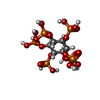

| #16: Chemical | ChemComp-LDZ /  MG132 MG132#17: Chemical |  Phytic acid Phytic acid |
|---|
-Details
| Has ligand of interest | Y |
|---|
-Experimental details
-Experiment
| Experiment | Method:  ELECTRON MICROSCOPY ELECTRON MICROSCOPY |
|---|---|
| EM experiment | Aggregation state: PARTICLE / 3D reconstruction method:  single particle reconstruction single particle reconstruction |
- Sample preparation
Sample preparation
| Component | Name: PA200-20S proteasome / Type: COMPLEX / Entity ID: #1-#15 / Source: NATURAL |
|---|---|
| Source (natural) | Organism:   Homo sapiens (human) Homo sapiens (human) |
| Buffer solution | pH: 7.5 |
| Specimen | Embedding applied: NO / Shadowing applied: NO / Staining applied : NO / Vitrification applied : NO / Vitrification applied : YES : YES |
Vitrification | Cryogen name: ETHANE |
- Electron microscopy imaging
Electron microscopy imaging
| Experimental equipment |  Model: Titan Krios / Image courtesy: FEI Company |
|---|---|
| Microscopy | Model: FEI TITAN KRIOS |
| Electron gun | Electron source : :  FIELD EMISSION GUN / Accelerating voltage: 300 kV / Illumination mode: FLOOD BEAM FIELD EMISSION GUN / Accelerating voltage: 300 kV / Illumination mode: FLOOD BEAM |
| Electron lens | Mode: BRIGHT FIELD Bright-field microscopy / Nominal defocus max: 2000 nm / Nominal defocus min: 1000 nm Bright-field microscopy / Nominal defocus max: 2000 nm / Nominal defocus min: 1000 nm |
| Image recording | Electron dose: 30 e/Å2 / Film or detector model: GATAN K3 (6k x 4k) |
- Processing
Processing
CTF correction | Type: PHASE FLIPPING AND AMPLITUDE CORRECTION |
|---|---|
3D reconstruction | Resolution: 3.1 Å / Resolution method: FSC 0.143 CUT-OFF / Num. of particles: 70412 / Symmetry type: POINT |
 Movie
Movie Controller
Controller













 PDBj
PDBj











